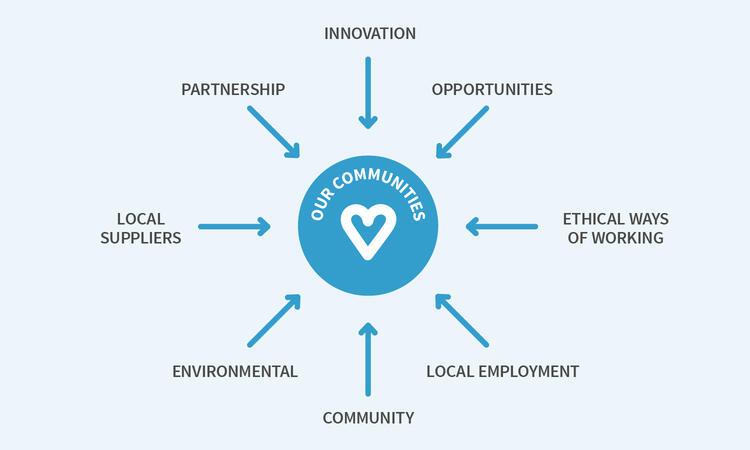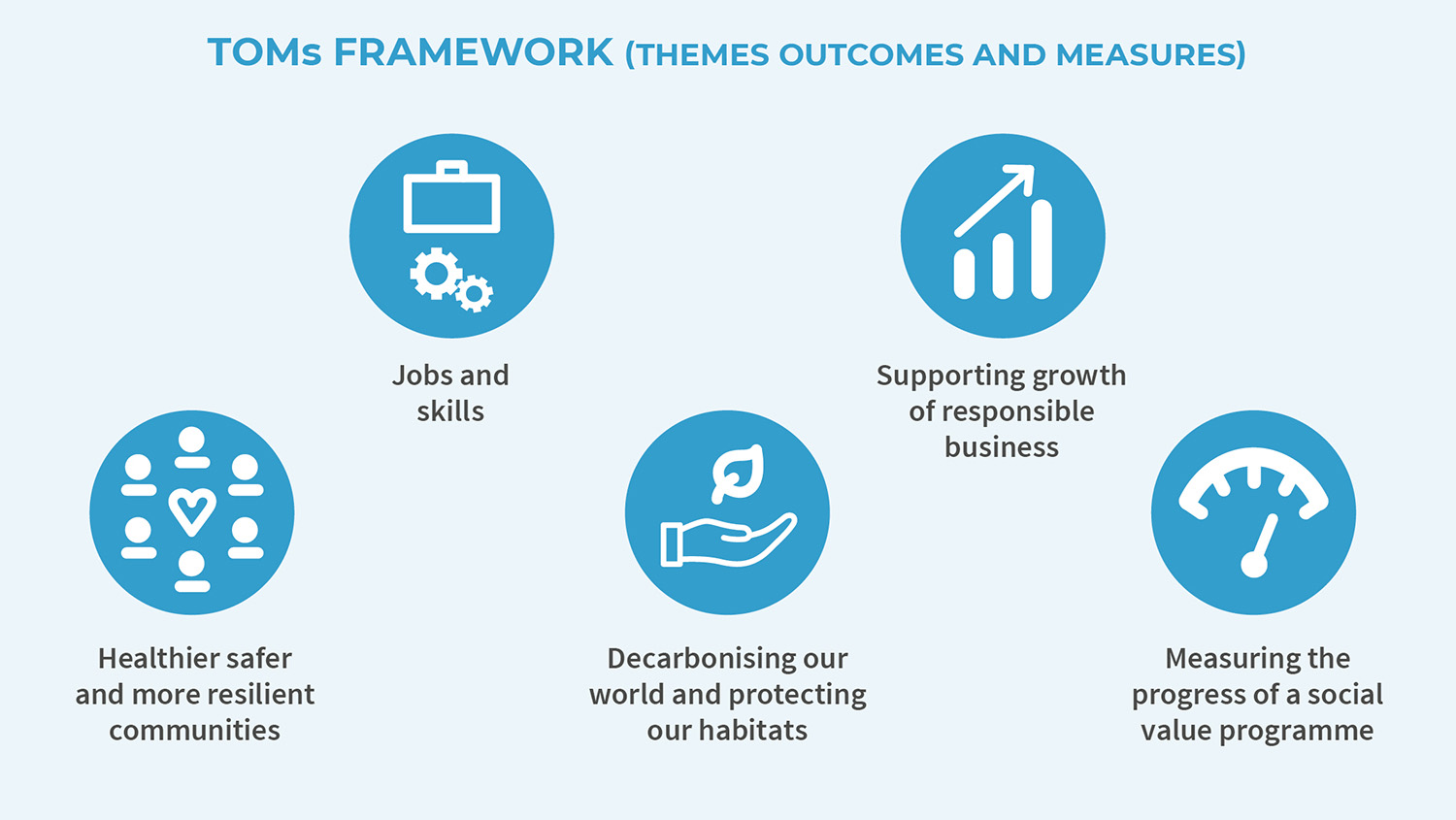GN 8.2: Social value opportunities
Guidance Note purpose
The purpose of this Guidance Note is to provide asset managers, property managers and facilities managers with information that will help to guide the development of social value activities in relation to commercial real estate.
Context
The real estate sector directly employs over 2.4 million people and contributes £117bn to the UK economy, representing six percent of total economic output and generating one million jobs a year. The associated potential to generate social value is significant and conservatively could create additional value of over £30bn per year1.
There are many ways to deliver social value. Identifying and prioritising stakeholders’ social value needs can help to shape the social value activities that are most relevant – and can add greatest value - to a property, its local community and society at large.

Responsibilities & Interests
The table below summarises the key activities associated with social value opportunities, and highlights where asset managers, property managers and facilities managers are likely to have a responsibility or specific interest.
- AM - Asset Manager
- PM - Property Manager
- FM - Facilities Manager
1. Jobs and skills
Stakeholder:
2. Supporting growth of responsible business
Stakeholder:
3. Healthier safer and more resilient communities
Stakegholder:
4. Decarbonising our world and protecting habitats
Stakeholder:
5. Measuring the progress of a social value programme
Stakeholder:
How to
Intro
Across the range of social value opportunities, the responsibilities and interest of asset, property and facilities managers are likely to have differ depending on local circumstances.
The kinds of social value themes that a materiality exercise is likely to identify are generally covered within the opensource TOMs framework (Themes Outcomes and Measures) which groups social value outcomes under the five headings below:

1: Jobs and skills
- Mentoring programmes: There various ways to organise successful mentoring programmes. These include, for example:
- Working with local schools and colleges to understand what benefit young people would derive from a mentoring programme.
- Setting up a mentoring programme within your building for less experienced members of your occupiers’ and facilities teams to be mentored by those with more or different experience.
- Skills based volunteering: The people within a property likely possess many varied skills, from those they use as part of their day job, to those they use outside of work.
Many voluntary sector organisations operate with limited resources and don’t always have the formal business skills they would ideally like. Conversely, individuals working within these sectors often have well developed attributes such as, for example, team building, motivation and partnership working.
Developing relationships with charities and community organisations that are relevant to the social issues identified as important to the local area presents an opportunity to work together for mutual benefit.
Creating a skills matrix by surveying people to highlight what skills they have that they would be willing to share can be a good place to start. Alternatively, opening conversations with community groups to find out what they need followed by a call-out to people in the building to see if they hold these skills.
Examples are as broad as marketing support for charities to more functional advice on accountancy to foreign language translation.
- Work experience: Many schools and colleges have more students seeking work experience than businesses or organisations who can accommodate them. Work experience provides a valuable way to build a relationship with a local school and to provide a positive experience for both young people and employees, who can gain skills in communication and coaching.
There is guidance around work experience in that the person carrying out the placement should be observing or carrying out tasks to try them out rather than fulfil a role within the organisation that would otherwise be completed by a paid member of staff.
Speaking with the local Department for Work and Pensions is usually a good place to start to understand the need and opportunity in a local area.
- Internships: Organising internships within the building can be an impactful way of building local relationships, bringing in fresh talent and perspective and opening up opportunity to people who otherwise may not get first-hand experience of the workplace.
Internships are usually longer placements than work experience and costs are at least covered, with some receiving a small payment too. Given the cost associated with such placements they can be trickier to organise, but they are almost always valuable for all involved.
2. Supporting growth of responsible business
- Local and/or socially led procurement: As the procurement spend from a property building is likely to be significant, there are numerous ways to deliver value through the supply chain.
Sourcing locally is a great way to support economic resilience, and looking for impact led businesses, such as social enterprise, can also extend the impact.
- Springboard for start-ups, young enterprise and cultural groups: Creative use of space to give profile to socially-led projects in the local area can be a great way of supporting the community and enriching a property’s space.
For example, as many schools and colleges run young enterprise projects, there are likely to be opportunities to invite them in to promote and sell their goods in your shared areas.
It is worth considering:
- Is there space to display art from local groups giving them exposure and profile?
- Are there any small local businesses that would benefit from agreed access to a property and its people?
- Wellbeing: A building has the potential to have huge impact on the wellbeing of people in and around it. By actively promoting and enhancing wellbeing, value can be added to the space. This can be through:
- The building itself, for example, ensuring there are spaces for reflection, adding in biophilia, making sure there is access to natural light, encouraging use of stairs over lifts, adding bike racks.
- Activities within the building, for example, mindfulness and yoga classes, or opportunities to connect socially.
- Mental health provision: It is useful to think about how a property can support the mental health of people using it.
There are a range of initiatives that specifically support mental health, for example, introducing Mental Health First Aiders, or running events with expert speakers on mental health.
3. Healthier safer and more resilient communities
- Support for local charities: There are numerous ways to support local charities and local communities.
The most appropriate type of support will depend on what’s required in a particular local area. Examples include:
- Literacy initiatives involving volunteers to read to children (safeguarding checks will generally be undertaken via the charity).
- Befriending older people.
- Skills based volunteering to help support digital skills.
When setting up partnerships with local charities it is important to:
- Have an open conversation at the outset about what support a property’s occupiers are, and are not, able to provide.
- Be clear about the terms of the relationship, for example, a one-off activity or ongoing engagement, financial or non-financial contribution, what information should be provided to track and measure engagement.
- Celebrate and support local diversity: Every community is different and the people within a property will come from a range of diverse backgrounds.
Celebrating diversity and local nuance is a great way of bringing people together, both virtually, or in person. This can be done to celebrate a variety of cultural events, or events of significance to the local community, while promoting a culture of tolerance and inclusivity.
- Youth panels: There is often value to be gained from inviting new voices to join discussions/debates that might be taking place within a property. There are numerous ways this can be done. One example is through working with a dedicated organisation, such as Debate Mate, which seek companies to present real life problems to young teams of debaters who come and ‘battle it out’ with an audience.
4. Decarbonising our world and protecting our habitats
- Community planting projects: The act of planting trees and plants can provide health benefits while also supporting the necessary drive to promote and protect biodiversity in our communities. Bringing people together to do this in or around a property, or the local area, can help improve the surroundings as well as support social connections.
- Wildlife protection programmes and engagement. Many charities are involved in the protection of the environment. Group activities, such as Keep Britain Tidy’s Big Litter Pick, and Surfers Against Sewerage beach cleans can be great ways to engage teams, meet new people and make a positive difference to the local environment.
- Green transport schemes: Introducing green transport schemes is a great way for people to contribute to the environmental effort while improving their health and wellbeing.
- Whether this involves car sharing that promotes social connection, or encouraging walking and cycling through provision of lockers or showers, these activities can provide an important source of social value.
5. Measuring the progress of a social value programme
Tracking and measurement is an important part of any social value programme, and should be considered as part of the planning social value activities.
Setting up processes to capture the kind of data that will be beneficial to a property’s stakeholders involves taking a proportionate approach and starting with data that is already available.
This may involve capturing quantifiable numbers around, for example:
- number of volunteers.
- hours volunteered.
- results of wellbeing surveys.
Alongside this, qualitative insights from those involved may also provide valuable feedback as well as supporting the development of case studies for communications purposes.
At a more advanced level, to begin to evaluate the socio-economic value of a social value programme, there are numerous specialists that can provide support.
The TOMS opensource framework provides a good starting point to understand the principles and methodology regardless of the supplier. As part of TOMS, proxy values derived from national data sources can enable socio-economic measurement of certain activities.
Related Guidance Notes
The following Guidance Notes contain related information:
- GN4.8: Template Action Plan
- GN7.1: Sustainable transport opportunities
- GN8.1: What is social value?
- GN 8.3: Incorporating social value within the supply chain
- GN9.1: Modern Slavery Act
- GN9.2: Living Wage Foundation certified services
- GN9.3: Embedding sustainability within waste management services
- GN9.4: Embedding sustainability within M&E services
- GN9.5: Embedding sustainability within cleaning services
- GN9.6: Embedding sustainability within security services
- GN9.7: Embedding sustainability within landscaping services
- GN11.1: Building User Guide
- GN11.2: Engaging occupiers
- GN11.3: Service charge considerations
- GN12.2: Valuable green spaces
- GN13.2: Health and wellbeing opportunities